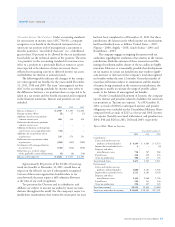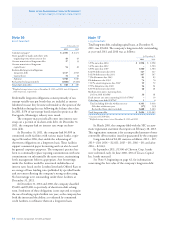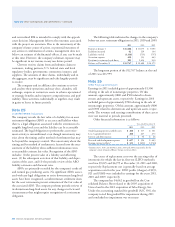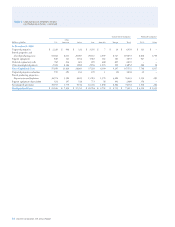Chevron 2011 Annual Report Download - page 65
Download and view the complete annual report
Please find page 65 of the 2011 Chevron annual report below. You can navigate through the pages in the report by either clicking on the pages listed below, or by using the keyword search tool below to find specific information within the annual report.
Chevron Corporation 2011 Annual Report 63
LESOP totaling $38, $97 and $184 in 2011, 2010 and2009,
respectively. e remaining amounts, totaling $225, $156
and $73 in 2011, 2010 and 2009, respectively, represent open
market purchases.
Employee Stock Ownership Plan Within the Chevron ESIP is
anemployee stock ownership plan (ESOP). In 1989, Chevron
established a LESOP as a constituent part of the ESOP. e
LESOP provides partial prefunding of the company’s future
commitments to the ESIP.
As permitted by accounting standards for share-based
compensation (ASC 718), the debt of the LESOP is recorded as
debt, and shares pledged as collateral are reported as “Deferred
compensation and benet plan trust” on the Consolidated
Balance Sheet and the Consolidated Statement ofEquity.
e company reports compensation expense equal to
LESOP debt principal repayments less dividends received
and used by the LESOP for debt service. Interest accrued
on LESOP debt is recorded as interest expense. Dividends
paid on LESOP shares are reected as a reduction of retained
earnings. All LESOP shares are considered outstanding for
earnings-per-share computations.
Total credits to expense for the LESOP were $1, $1 and
$3 in 2011, 2010 and 2009, respectively. e net credit for
the respective years was composed of credits to compensation
expense of $5, $6 and $15 and charges to interest expense for
LESOP debt of $4, $5 and $12.
Of the dividends paid on the LESOP shares, $18, $46
and $110 were used in 2011, 2010 and 2009, respectively, to
service LESOP debt. No contributions were required in 2011,
2010 or 2009, as dividends received by the LESOP were
sucient to satisfy LESOP debt service.
Shares held in the LESOP are released and allocated
to the accounts of plan participants based on debt service
deemed to be paid in the year in proportion to the total of
current-year and remaining debt service. LESOP shares as
of December 31, 2011 and 2010, were as follows:
Thousands 2011 2010
Allocated shares 19,047 20,718
Unallocated shares 1,864 2,374
Total LESOP shares 20,911 23,092
Benet Plan Trusts Prior to its acquisition by Chevron,
Texaco established a benet plan trust for funding obliga-
tions under some of its benet plans. At year-end 2011,
thetrust contained 14.2 million shares of Chevron treasury
stock. e trust will sell the shares or use the dividends from
the shares to pay benets only to the extent that the company
does not pay such benets. e company intends to continue
to pay its obligations under the benet plans. e trustee will
vote the shares held in the trust as instructed by the trust’s
beneciaries. e shares held in the trust are not considered
outstanding for earnings-per-share purposes until distributed
or sold by the trust in payment of benet obligations.
Prior to its acquisition by Chevron, Unocal established
various grantor trusts to fund obligations under some of its
benet plans, including the deferred compensation and sup-
plemental retirement plans. At December 31, 2011 and 2010,
trust assets of $51 and $57, respectively, were invested primarily
in interest-earning accounts.
Employee Incentive Plans e Chevron Incentive Plan is an
annual cash bonus plan for eligible employees that links
awards to corporate, unit and individual performance in the
prior year. Charges to expense for cash bonuses were $1,217,
$766 and $561 in 2011, 2010 and 2009, respectively.
Chevron also has the LTIP for ocers and other regular sala-
ried employees of the company and its subsidiaries who hold
positions of signicant responsibility. Awards under the LTIP
consist of stock options and other share-based compensation
that are described in Note 20, beginning on page 56.
Note 22
Equity
Retained earnings at December 31, 2011 and 2010, included
approximately $10,127 and $9,159, respectively, for the com-
pany’s share of undistributed earnings of equity affiliates.
At December 31, 2011, about 67 million shares of
Chevron’s common stock remained available for issuance from
the 160 million shares that were reserved for issuance under
the Chevron LTIP. In addition, approximately 258,000 shares
remain available for issuance from the 800,000 shares of the
company’s common stock that were reserved for awards under
the Chevron Corporation Non-Employee Directors’ Equity
Compensation and Deferral Plan.
Note 23
Restructuring and Reorganization
In the rst quarter 2010, the company announced employee
reduction programs related to the restructuring and reorga-
nization of its downstream businesses and corporate stas.
Total terminations under the programs are expected to be
approximately 2,700 employees. About 1,300 of the aected
employees are located in the United States. About 2,500
employees have been terminated through December 31, 2011,
and the programs were substantially completed by the end of
2011. Substantially all of the remaining employees designated
for termination under the programs are expected to leave
in 2012.
A before-tax charge of $244 was recorded in rst quar-
ter 2010 associated with these programs, of which $138
remained outstanding at December 31, 2010. During 2011,
Note 21 E mployee Benefit Plans – Continued
























